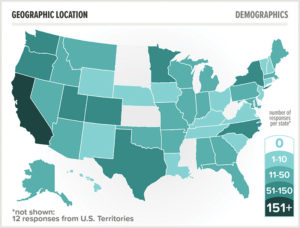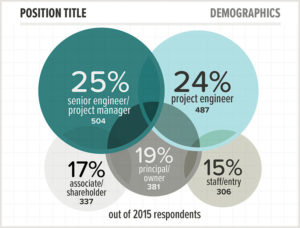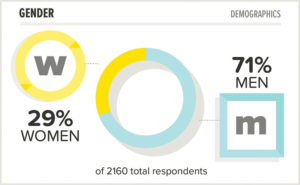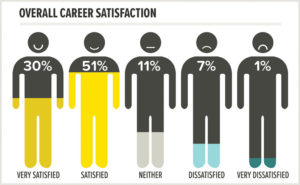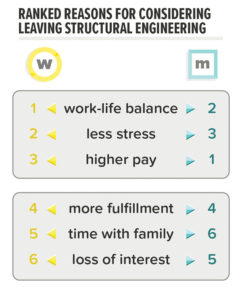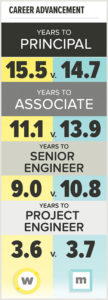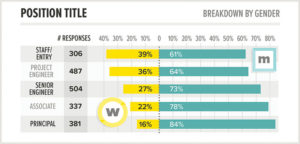Structural Engineering Engagement and Equity (SE3) Committee Survey Results
The mission of the Structural Engineering Engagement and Equity (SE3) Committee of the Structural Engineers Association of Northern California (SEAONC) is to study and improve engagement and equity in the structural engineering profession. In early 2016, SE3 administered a nationwide survey of practicing and formerly practicing structural engineers. The effort received over 2,100 completed responses. The survey questions aimed to investigate overall career satisfaction across a range of metrics, including career development, trajectory, and advancement; compensation, benefits, and flexibility; work environment and work-life balance; and the effects of caring for children or other dependents.
This article highlights survey findings regarding overall career satisfaction, development, and advancement. A full report that includes findings on compensation and work-life balance can be found at SE3project.org.
Demographic Overview of Survey Respondents
- 2,161 completed responses were received from currently and formerly practicing structural engineers.
- Responses were received from 46 states, as shown in Figure 1, though approximately half of the responses were from California.
- 7% of the respondents were formerly practicing structural engineers who had left the profession or retired.
- Respondents were relatively well-distributed among position titles, as shown in Figure 2.
- 52% of the total respondents had children. By gender, 57% of men had children, while only 38% of women had children.
- Nearly 50% of the respondents were under the age of 35.
- 40% of the respondents had an SE license, 73% had a PE license, and 76% had an EIT certificate.
- 29% of the respondents were women, as shown in Figure 3.
Overall Career Satisfaction
One of the career satisfaction questions asked: “How satisfied are you with your choice of a career in structural engineering?” Respondents overwhelmingly answered positively, with 81% reporting “satisfied” or “very satisfied” and only 8% reporting “dissatisfied” or “very dissatisfied” (Figure 4). However, when asked if they had ever considered leaving the profession, 56% of the respondents responded affirmatively.
The survey responses suggest that overall career satisfaction stems from a variety of sources, including pay/compensation, work-life balance, career advancement, and work environment. Of these factors, men and women cite distinctly different sources for their satisfaction (or lack thereof), as do respondents of varying ages and positions.
Overall, three factors that correlated strongly among those who reported the highest satisfaction with their career were:
- Holding more senior positions within their companies
- Being assigned daily tasks that align with their career objectives
- Being a parent
Reasons for Leaving the Profession
Men and women both reported that their top reasons for considering leaving the profession were to seek better work-life balance, less stress, and higher pay. Women rated work-life balance highest among these factors, while men rated pay as their top reason (Figure 5). For respondents who had left the profession (not including those who had retired), the findings were similar, but with the addition of one notable reason: poor management/leadership.
Career Development
Thirteen percent of respondents indicated being “dissatisfied” or “very dissatisfied” with their career development, which includes daily activities and job responsibilities, professional development opportunities, and career advancement. While most respondents were relatively satisfied with their career development, some significant findings were revealed regarding this topic, including differences in perceptions between managers and staff, the benefits of mentorship, and variations based on gender.
Management vs. Staff Perceptions
Managers and staff have notably different perceptions of expectations for advancement and the work environment. Compared to all other position levels, principals/owners are 43% more likely to “agree” or “strongly agree” that expectations for advancement are effectively communicated in their firms. Similarly, when evaluating opportunities for advancement, principals/owners are 24% more likely than all other staff to believe that equal opportunities for advancement exist in their firms.
Principals/owners are also less likely than all other staff to believe that formal business management training is essential. This is in stark contrast to a recent study that found that 98% of managers in the United States feel that more management training is needed in their own firms. In the study, 87% percent of those surveyed wish they had received more management training before assuming their current roles, and those same managers agreed that companies need to develop better ways to evaluate managerial ability (Grovo, 2016).
Additionally, aligning employees’ daily tasks with their career objectives was found to be one of the factors most highly correlated with satisfaction, indicating that employees would be better served if this were a prioritized goal for management. Respondents who experienced this alignment were significantly less likely to consider leaving the structural engineering profession. This finding applies to both men and women.
Mentorship
Respondents with identified mentors reported being more satisfied with their career advancement/trajectory and overall career choice than those without a mentor. Of the 1,943 engineers who responded to questions regarding mentorship, over half (55%) indicated that they had at least one mentor who strongly influenced their career path. Eighty-three percent of respondents who have a mentor reported being “satisfied” or “very satisfied” with their career advancement/trajectory, while only 67% of respondents without a mentor reported the same. Men and women reported having mentors at roughly equal rates.
People who did not indicate having mentors were 22% more likely to consider leaving the profession. This is consistent with comprehensive research that documents the benefits of mentorship. One recent study by the Society of Women Engineers highlights the benefits to both employers and employees, noting that mentorship often facilitates a sense of connectedness to the organization, increases satisfaction, and reduces turnover (Amelink, 2008).
Gender Differences
Men were 20% more likely than women to agree that opportunities for advancement are equal across genders. However, women were 23% more likely to be dissatisfied with their career advancement than men. This effect increased over time; for each year of experience, women were significantly less likely to report being satisfied with their career progress.
However, the data showed that women advance at a faster rate than men for all positions except principal/owner. As shown in Figure 6, the average number of years that it took for female respondents to reach the senior engineer/project manager position was 9.0 years, while male respondents reached this position, on average, in 10.8 years. Similarly, female respondents reached the associate/shareholder level in 11.1 years, while males achieved this level in 13.9 years, on average. At the principal/owner level, however, it took female respondents 15.5 years, on average, to attain this title, while male respondents reached this level after only 14.7 years.
Despite the apparent faster rate of advancement of the women surveyed, the number of women decreases significantly at each successive position. The highest ratio of women to men occurs at the staff/entry level (39% women) and the lowest ratio occurs at the principal/owner level (16% women), as shown in Figure 7.▪
References
Amelink, C.T., 2008, Overview: Mentoring and Women in Engineering, SWE-AWE-CASEE ARP Resources. Last accessed November 11, 2016.
Grovo, 2016, Good Manager, Bad Manager.

